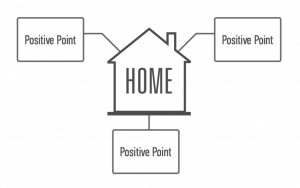
Who tells your company’s story best?
When it comes to telling your company’s story, who’s your best storyteller? Is it your founder, CEO, salespeople, marketers, human resources, or customers?
This question reminds me of the story of 6 blind men. When an elephant arrived in a village in India, 6 blind men went to observe it by touch.
The first man touched the elephant’s leg, and proclaimed it a pillar. The second touched the tail and thought it a rope. The third touched the trunk and thought it a tree branch. The fourth touched the ear and felt a big hand fan. The fifth touched the elephant’s belly and felt a huge wall. The sixth touched the tusk, which felt like a solid pipe.
Then the men fell to arguing. Fortunately, at that exact moment, a wise man passed by.
He helped the blind men understand that none of them were wrong, all of them were right. But each had felt only one facet of an elephant.
Similarly, when you ask people in a company, “What’s your company’s story?”, you hear different answers from each. Each sees one aspect of a company’s story, yet no one gets the complete picture.
That’s why marketers play such a central role in helping companies tell their stories better.
In 3 easy steps, you can discover and build a story that helps your company win customers, investors and employees.
Step 1: Capture today’s stories. Start by rounding up everyone’s story. Convene executives, salespeople, marketers and product experts to capture today’s version of your company’s story.

We help clients do this work by convening workshops to create a 1-PageTM Message Map.
In our workshops, we ask each person to write down the company’s story as a Message Map – with 1 home base and 3 positive points – in 23 or fewer words. That makes a perfect elevator speech.
Then each tells his or her version of the company’s story. With 10 people in the room, we usually hear 10 different stories – just like the blind men describing the elephant.
Each person’s story contains a valuable kernel of truth. To start, capture all these kernels.
But don’t expect the pieces to fit together logically yet. If the story doesn’t make sense inside the company, imagine how it sounds to outsiders!
When the team realizes that telling 10 different stories won’t work, it’s a moment of truth. Aha! Together they realize: our story today is confusing, not compelling.
Step 2: Capture your customer’s questions. Write down every single question that customers ask your service people, salespeople, product people and marketers over a period of time, say 4 to 6 weeks.
Yes, you can expect people to groan when they hear a request like this. But as you collect customers’ questions, you build a foundation for a powerful arsenal of content marketing.
Build your customers’ questions into a spreadsheet and tag them. Analyze them to reveal:
- Which issues are uppermost in customers’ minds?
- What are customers’ worries, fears and pain points?
- Are the answers to these questions easy to find on your website?
- Which information do customers seek at each step in the buying journey?
- Which exact words do customers use?
- Which members of the buying team are asking which questions?
- How far along the buyers’ journey are your customers?
This analysis enables you to create content that addresses all your customers’ questions – the questions that your customers Google about. Capture them in writing and create content to address them, and you’ll improve your search rankings.
Step 3: Align your company’s story with your customers’ questions. Now that you’ve learned all the facets of the company story from insiders, and captured questions from customers and other outsiders, you can align all these facets to create one compelling, crystal-clear message.
With all these pieces in place, it’s easy to answer your customers’ most important question – what’s in it for me? (WIIFM?)

Make your business story easy to tell, and consistent no matter who tells it, with a Message Map. Get your whole choir onto the same page, so everyone sings from the same songbook.
A consistent message is so rare, it makes your company really stand out in the marketplace.
One way that companies can build credibility over time is with a consistent message. Neuroscientists find strong links between consistency and credibility.
In companies where everyone tells the story their own way, the company sounds like the Tower of Babel. That baffles customers, employees and investors – and it doesn’t help your company succeed.
A 1-Page Message Map turns cacophony into harmony. It enables your company to communicate with absolute consistency through all media – digital, print and live – and across all your markets – local, national and global.
With a Message Map, your company can always deliver the right message – one that sounds good to everyone, builds credibility and trust over time, and paves the way to future customers and revenue.
Related Posts
Test Your Message Before Launch: Make It Clear, Compelling, Consistent & Concise
Is your new message ready for launch? Look through the eyes of your audience to make sure your message passes the 4-Cs test: It’s...
Who needs better messaging?
7 ideas on how you can create better messaging When you ask Sales what they want the most from Marketing, their answer may surprise...
Reframe Your Story, Unlock Hidden Shareholder Value
Telling your company story well can unlock tremendous value. By reframing its story, one public company unlocked $2.9 billion in shareholder value. The tool they...
Top 100 Content Marketing Question: How do you capture customer questions?
To make your content great, teach before you sell. That insightful advice comes from Marcus Sheridan’s book, They Ask You Answer. To make sure you...





